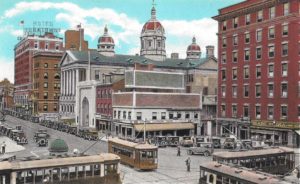
Continental Square in York, Pa.
The metallic reverberating sound of gongs repeatedly sounded throughout downtown York, Pa., in August 1925. It was a sound people recognized as the alert on a fire truck. Somewhere in York, a fire was burning.
“During the disturbance patrons of theaters, hurriedly snatched their wraps and fled from the amusement places to ‘go to the fire.’ Others telephoned or went to their homes,” The York Dispatch reported.
People attending a municipal band concert at Farquhar Park heard the gongs over the music and streamed out of the park, seeking the fire or their homes to make sure it wasn’t burning.
The problem was that there was no fire. “A callithumpian band mounted on a truck which also carried, despite their objections the bride and bridegroom, coursed about downtown streets for about an hour last evening,” The York Dispatch reported.
According to the Merriam-Webster website, “callithumpian” is a word that dates back to 19th century England to describe a very boisterous gathering. A callithumpian band wasn’t a performing band. The musicians used noisemakers, such as pots, tin horns, and cowbells, more than instruments. With this callithumpian band, one instrument was gongs with a tone that matched the fire gongs.
While the noise was certainly disturbing, because the bells and gongs mimicked those used by the city’s fire engines, it “gave people who heard but could not see the unique procession, the impression that the whole fire department was out hunting a blaze and could not find it,” the newspaper reported.
The groom was J. Morris Crum who had married Alice Thompson in late July in the Grace Evangelical Church. When they returned from their honeymoon to their home on East King Street, they were carried away to a truck by the serenaders.
At first, the noise truck seemed content to circle Continental Square, but after it went around several times, Patrolmen Binder, whose beat the square, stopped the truck. He informed the driver that Mayor Ephraim Smyser Hugentugler had recently ruled that vehicles could not circle the square more than once.
“The information did not seem to discourage the celebrants, for they eliminated the square but kept in the central section of the city for some time afterward,” The York Dispatch reported.
After the band continued to cause concern among the citizens, several policemen stopped the truck along its new route. The driver of the truck produced a permit signed by the mayor and the police officers reluctantly let the loud band continue on.
It turns out that the permit was a fake, a fact that wasn’t discovered until the next day.
After an hour or so of noise and fear, the group on the truck finally tired and broke up.
Mayor Hugentugler was asked the next day why he had signed the permit and the mayor denied having done so.
“He said that if he had been in the city last night the party would have been arrested,” the newspaper reported.
He added that if something similar happened again, he would order the police to make “wholesale arrests” because the group’s actions had overstepped the bounds of propriety.
Hugentugler served as York’s mayor from 1916 to 1928. He was a man known to take strong actions. During World War I, he had banned anti-war meetings in the city and prohibited the publishing of anti-war literature, according to the Political Strange Names blog. Hugentugler, “even went as far as to erect a wooden bust of Kaiser Wilhelm in York’s Centre Square that citizens could pound a nail into (at the low price of ten cents a nail!),” the blog noted.
You might also enjoy these posts:
- York County’s first supermodel
- Drag racing through Gettysburg before there were cars
- Welcome to Bird Land